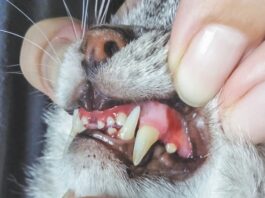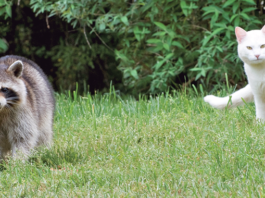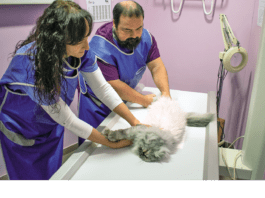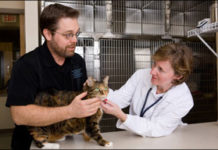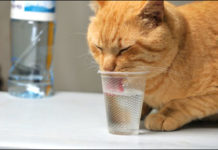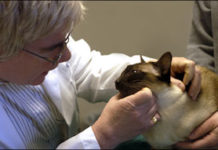Dental Disease: All Too Common
It may surprise you to learn that dental disease is the most common disease in cats. In fact, approximately 50 percent of all cats show signs of gum and teeth problems by the time they reach adulthood. What can you do to prevent it from happening to your cat? Types of Dental Disease. Periodontal disease - which includes gingivitis and periodontitis - is a serious condition that, when left untreated, can lead to tooth loss and may even cause damage to vital organs because bacteria from the mouth can circulate through the bloodstream.
Understanding Glaucoma
The eye is an amazing, delicate organ. Cells within the eye normally produce a clear fluid (aqueous humor) that serves to nourish and maintain the shape of the eye. When the balance between the production and the drainage of fluid is upset, glaucoma can result. Decreased drainage of fluid causes increased pressure (and pain) within the eye, often resulting in damage to the optic nerve and, consequently, loss of vision. While glaucoma is much less common in cats than in dogs, it still poses the same high risk of blindness if left untreated. In fact, even if diagnosed early on, treatment is not always successful.
Popular Flea and Tick Products Now Available Over-the-Counter
According to Bayer Animal Health, Advantage and Advantix are now available over-the-counter. Formerly available only through veterinarians, these flea and tick products will now be sold at pet specialty retail and internet outlets.
The Danger of Hairballs
Every so often, your otherwise fastidious cat will do an alarming and somewhat disgusting thing. Shell awake from a peaceful nap, rise up on her paws, retch convulsively for a moment or two, and spit up what may appear at first glance to be a damp clump. What the animal has disgorged - in the middle of your kitchen floor or, worse yet, in the middle of your prized Persian rug - is a trichobezoar, a wad of undigested hair that is commonly referred to as a hairball. Despite the term, disgorged hairballs are not usually round. They are often slender and cylindrical, shaped more like a cigar or sausage than a ball. According to Richard Goldstein, DVM, an associate professor of small animal medicine at Cornell Universitys College of Veterinary Medicine, a spit-up hairballs elongated shape is imparted by the narrow food tube (esophagus) in which it develops or through which it passes on its journey from the cats stomach to the outside world. However, he notes, a hairball that is not disgorged and remains in the stomach will indeed be round - "like a sponge or a rolled-up sock," he says.
Ask Elizabeth: April 2010
Is it really possible that my cat has acne? Crumbcake is a handsome, slightly chubby, brown tabby cat who we adopted from the SPCA five years ago. He has always been quite healthy; we take him to our veterinarian every year for his check-up, and we havent had any worries about him. Imagine our shock when at this years examination, our veterinarian diagnosed "chin acne" on our cat! Crumbcakes chin is a little swollen, a little red, and he has a number of what look like blackheads along the edge of his lower lips.
Short Takes: April 2010
Ingestion of foreign bodies - including string-like objects - is a common problem seen in feline veterinary medicine. Foreign bodies may cause partial or complete gastrointestinal (GI) obstruction, which results in disturbances of fluid and electrolyte balance as well as dehydration. Damage to the intestinal tract can also occur. This study ("Gastrointestinal foreign bodies in dogs and cats: a retrospective study of 208 cases" in the Journal of Small Animal Practice, 2009) reviewed the records of 208 cases of GI foreign bodies in dogs and cats that were brought in to the RSPCA Greater Manchester Animal Hospital in the UK from June 2003 to May 2007.
The Female Cat in Heat
The yowls of a cat in heat are unmistakable. When a female cat needs to mate, you should expect incessant crying, strange posturing and constant attempts to escape outdoors to waiting males. The best thing you can do about your cat in heat is to prevent it from happening in the first place. Its a smart idea to have her neutered before her first heat cycle. However, sometimes thats not possible. So if youve never witnessed a cat in heat, heres what you should expect.
Diagnosis: Kidney Disease
Your cats kidneys play a central role in almost all of its bodily processes. They help to control the blood pressure and regulate the amount and chemical consistency of fluid in the bloodstream. They produce a variety of vitally needed hormones and enzymes, and they contribute to the production of red blood cells. They also remove metabolic waste, such as urea, mineral salts and poisonous substances, from its blood. This is accomplished by kidney (renal) tissue containing hundreds of thousands of tiny filtration units called nephrons. When waste-laden blood enters the kidneys through the renal artery, it moves through progressively smaller vessels until it reaches these nephrons, where it is filtered through microscopically minute structures called glomeruli. The cleansed blood about 95 percent of the total fluid volume that originally entered the kidneys then circulates back to the heart for yet another voyage through the body. Meanwhile, the remaining fluid, containing the waste products, is passed along as urine from the kidneys to the bladder and eventually excreted.
Feline Heartworm Infection: Serious
As springtime arrives throughout the U.S., the steamy days and nights of summer cannot be far behind. This means, of course, a proliferation of mosquitoes. For you, this is an annoyance. For your cat, these bothersome little creatures can pose a major health problem. Among all of the various disorders that can endanger a cats physical well-being and perhaps threaten its life, few are more insidious than feline heartworm disease, a potentially life-threatening condition that occurs when a parasitic worm called Dirofilaria immitis gets into an animals system. And the only way in which this worm can enter your cats body is through a mosquito bite.
The Truth About Toxoplasmosis
Toxoplasmosis is a fairly common zoonosis (a disease that can be shared between humans and animals); 30 to 40 percent of adult humans, and roughly the same percentage of cats, have antibodies that indicate prior exposure to the organism that causes the disease. Prevention is Best. Nevertheless, its particulars are still unfamiliar to many people. The disease poses a threat primarily to fetuses and to immunosuppressed patients, but an understanding of the organisms life cycle, how transmission occurs and can be avoided, and the signs of infection can greatly reduce the risk of serious disease.
Short Takes: March 2010
Primary septic peritonitis is an abdominal infection without a primary focus, such as a perforated bowel. The most common cause in cats is feline infectious peritonitis (FIP). Unfortunately, little is known about primary bacterial septic peritonitis in cats. The investigators (" Primary bacterial septic peritonitis in cats" in the Journal of the American Animal Hospital Association, Nov-Dec 2009) examined the medical records of twelve cats diagnosed with primary bacterial septic peritonitis and identified significant characteristics associated with this condition.
Squamous Cell Cancer: Dangerous
During your cats routine physical exam, youre likely to observe the veterinarian carefully studying the animals face, gently stroking its nose, and fondling its ears. This is not merely a show of affection. Rather, the veterinarian may be searching for tiny, scabby sores on the cats skin that could indicate the presence of squamous cell carcinoma (SCC) - a skin cancer that, if caught in its early stage, will most likely be harmless and easily treated. If the skin eruptions go unnoticed, however, the cancer can progress, spread to other parts of the body and ultimately prove fatal.


